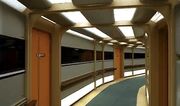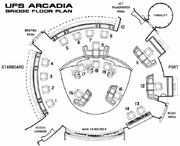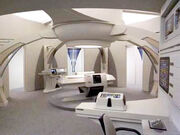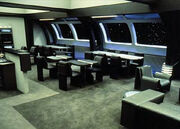- You may be looking for Quantum class (Starship Swiftwind).
| STARSHIP CLASS | |
| Quantum | |

| |
| Type: | Explorer |
| Length: | 429 m |
| Beam: | 196 m |
| Draft: | 64.5 m |
| Max. warp: | warp 9.99 |
| Max. speed: | quantum slipstream capable |
The Quantum-class starship was an advanced type of Federation Starfleet vessel of the 2380s. (Star Trek: Arcadia)
Profile[]
The Quantum-class starship, introduced in late 2379, began as a redesign of a previous Intrepid-class vessel. The first commissioned ship of this class, the UFS Arcadia (launched in 2378), was Intrepid class (uprated), featuring most major advances of the time, plus the first stable, working quantum slipstream drive (QSD) developed exclusively by the United Federation of Planets. These ships carried the prefix "U.F.S.", standing for United Federation Starship, reflecting the Federation's united goals. The manufacture of QSD ships halted in late 2378 due to security concerns, with Arcadia being the sole ship of her kind until 2379, when the ban was lifted. Rather than resume production of uprated Intrepid-class vessels, Starfleet Research and Development opted to produce a new class based on studies made in the first year of Arcadia's service, as well as incorporating advances in other areas of starship operation and hull-variable geometry. Arcadia underwent an extensive refit over the course of three months (late 2379-early 2380), becoming the prototype for this design.
While combining aspects of both Intrepid-class and Prometheus-class starships, Quantum-class vessels were technologically superior as well as proportionately larger in dimension. The major feature was quantum slipstream drive, requiring reconfigured hull geometry and differences in internal design and structural efficiency. These ships were optimized to permit quick swaps of modular sections in accord with specific mission profiles and design updates, such as new bridge modules (the bridge was located on Deck Three). Combat proficiency was also greatly enhanced, in keeping with the Federation's credo of a "golden age" of peace in the galaxy through superior technology and firepower. Some notable examples included:
- "anticloaking" sensors--the ability to detect cloaked ships;
- phase-shifting "smart" torpedoes (which altered trajectory to match course & position of targets and penetrate shields by adapting to their power output);
- regenerative multi-matrix shielding;
- and, in areas of high conflict, self-reproducing ablative armor.
Cumulatively, this made Quantum-class ships highly invulnerable, to the point that battle was brief and rarely necessary, allowing them to focus on safe, long-distance exploration despite potentially hazardous areas or hostile parties.
Quantum-class ships sustained a maximum warp velocity of 9.99 for up to six (6) hours. Holoemitters installed throughout these ships allowed holographic crew supplements to operate in all areas. Other notable additions included extra decks for scientific research facilities, supporting dedicated multi-tasking science departments and a wide array of auxiliary craft (necessitating double-tier flight deck capacity), supporting forays of a range deeper into unexplored space than most Federation starships of the time. Overall, this made the Quantum class superbly equipped for long-range exploration, diplomacy and defense. The first ship of the line was Arcadia, refitted from an Intrepid-class frame in late 2379.
Early Quantum-class ships bore place-names from regions of ancient Greece, mainly in the Peloponnesus. As the Quantum Fleet expanded during the 2380s, ship names selectively indicated lofty goals, concepts and states of being, reflecting a feeling of "manifest destiny" and social evolution, as the Federation elevated itself to the status of a galactic superpower. By 2385 twelve (12) such vessels existed. Thirteen had been commissioned, built and launched, with one destroyed (the UFS Messenia in 2382, replaced by the UFS Celestial). Twenty-five more were planned for launch by 2387.
Quantum-class starships are more than highly advanced platforms for space travel and exploration. They are a testament to the persistence and ingenuity of thinking beings, with a will to progress and uncover the mysteries of the unknown. Quantum-class design would not have been possible if not for discoveries and developments in prior years by Starfleet's exploration and scientific programs. Advances such as slipstream drive, subspace transporters, artificial wormholes (Lenara Kahn, 2370s), improved energy systems and long-range subspace monitoring made this class possible. Thus, it's a culmination of these many concerted and noble efforts, and evidence that through cooperation, vision, and purpose, anything is possible.
Accommodation[]
- Personnel: 100-300 (crew and civilians) (varied per ship and mission profile)
- Standard passenger limit: 300
- Maximum evacuation capacity: 1500
Power plant[]
- One (1) 2000+Cochrane warp core feeding two (2) nacelles
- Two (2) impulse modules
- Quantum singularity-based compression power stream system linked to main navigational deflector, backed by complementary benamite crystal tray (the "Q-core")
Performance[]
- Maximum sustainable warp velocity: Warp 7
- Absolute maximum warp velocity: 9.99 (for 6 hours)
- Maximum exploration endurance: QSD factor 8.125 for 6 months
- Expected duration: 150 standard [Earth] years
Transporters[]
- Standard (8- to 10-person capacity; varies): Seven (7) (one (1) on Deck 3, aft of main bridge)
- Cargo: Two (2)
Armament[]
Directed energy weapons[]
- Ten (10) type XV phaser arrays
- Four (4) variable-yield torpedo launchers - 2 fore, 2 aft
- Torpedo capacity: 100, variable yield (photon, quantum, smart, transphasic, etc.)
Shields[]
- Standard - Multi-matrix regenerative/rotating frequency. Incorporated metaphasic advances, allowing travel within a star's coronasphere, as well as refractive distribution capacity, absorbing and redistributing offensive energies, all on rotating modulations.
- Hull-reinforcing ablative armor - Self-regenerating through specialized free-standing holographic generators located aft of main engineering.
- Deflector screens (navigational standard)
- Optional cloaking device (hull conforming)
Auxiliary craft[]
- The number and type of supplemental/support vessels varied per ship. Approximate basis is as follows. Each ship of this class carried replicator technology and spare parts permitting construction of replacements/extras as needed.
- (2-3) runabouts
- shuttlecraft
- 1 › type-9 personnel shuttle
- 1 › type-11 heavy shuttle
- 1 › type-20 freight shuttle boasting one (1) ATV (all-terrain vehicle)
- 8 › "Sphinx"-class work bees
Upgrades[]
Interior design[]

A typical corridor
Quantum-class interiors were designed for comfort, to foster a sense of well-being among personnel. While the major command sections maintained form and functionality above all, there remained a much more "relaxed" feel in the design of many of these areas.
Bridge[]

UFS Arcadia bridge floor plan
The bridge was located on Deck Three. Like most Federation starship bridges, these modular components could easily be swapped out (via transporters on the Quantum class). Known Quantum-class bridge designs mostly bore aspects similar to those of the Intrepid class or Sovereign class. Placing the bridge on Deck Three was the result of a Starfleet tactical decision, since the bridge is a ship's operational "brain" center, and highly vulnerable atop the saucer sections of most ships.
While the Quantum-class bridge featured the traditional main viewscreen, in addition to several smaller, corollary viewscreens allocated to operational positions, the main source of extravehicular visual data came from the "holosphere", a configurable, spherical holographic projection generated at the center of the bridge, before the ring of command-officer stations. In 2385 Quantum-class ship interiors were laterally redesigned to support wide-scale holographic interfacing, in tandem with the ship's extensive array of internal holoemitters.
Observation lounge[]
Main engineering[]
Medical facilities[]
Sickbay[]

Sickbay
Labs[]
Counselor's office[]
The ship's counselor had his or her own office, located on Deck 5, where they could meet privately with crew-members needing psychological therapy.
Scientific departments[]
Deck 7[]
Science labs[]
- Exobiology
- Cultural Anthropology
- Cybernetic Sciences
- Planetary Sciences
Deck 8[]
Science labs[]
- Astrophysics
- Stellar Cartography
- Quantum Cartography
Arboretum[]
Transport and cargo[]
Transporter rooms[]

Transporter room
Quantum-class ships generally had two (2) cargo transporters on Deck 2. These transporters received and dispensed offboard shipments to the rest of the ship, and into Cargo Bay 3 storage on Deck 13.
In addition, there were seven (7) personnel transporters: two (2) on Deck 4, two (2) on Deck 5, and two (2) on Deck 9, each with anywhere from eight-to-ten person simultaneous beaming capacity. There also existed a transporter room on Deck 3, directly accessible to the bridge, for ease of bridge officers' passage to and from the ship.
Shuttlebays[]
The Shuttlebay (also called the Flight Deck), located on Deck 10, was divided into two sections, Shuttlebay 1 and Shuttlebay 2, located at the aft end of the stardrive section, below a hangar storage area on Deck 9 for embarked craft.
Cargo bays[]
There were three (3) cargo bays: Cargo Bay 1 on Deck 2, Cargo Bay 2 on Deck 4, and Cargo Bay 3 on Deck 13.
Crew quarters[]
Crew quarters on a Quantum-class ship were situated throughout the vessel, concentrated on Decks 4, 6, 7 and 8, with additional quarters on Deck 12 for engineering personnel. Both Starfleet personnel and civilians shared these quarters, although strictly civilian assignees, along with passengers, were placed in quarters on Deck 8. Deck 12 also contained special quarters (the "aquarium") built for a Wembahdnaw scientist residing on board.
The captain's quarters were located on Deck 4, to permit quick and easy access to the bridge on Deck 3. Though similar to officers' quarters, they were slightly larger before the holographic internal reconfiguration of 2385. Afterwards, they could be customized to personal desire for size and comfort, within reason. Stephen April maintained quarters no larger than any other command-level officer on board. These quarters contained a desk area and work terminal (usually near the door to an adjacent corridor passage).
Officers' quarters also occupied Deck 4, for ranks of Lieutenant and above.
Junior officers' quarters lined Decks 6 and 7, split between junior-grade Lieutenants and Ensigns on Deck 6, and other Ensigns along with non-commissioned personnel on Deck 7.
Mess[]

Likeness of the ship's mess
The ship's mess hall was located on Deck 6.
Holodeck[]
Quantum-class ships typically carried two holodecks, located on Decks 7 (Holodeck 1) and 8 (Holodeck 2).
Commissioned ships[]
As of early 2386, only thirteen (13) Quantum-class ships had been launched. Twenty-five (25) were planned to be in service by 2387.
- UFS Arcadia (NCC-A1)
- UFS Caledonia (NCC-A2) - Second of the class. "Caledonia" was the ancient Roman name for Scotland.
- UFS Celestial - Replaced the destroyed UFS Messenia in 2382.
- UFS Discovery
- UFS Hesperia
- UFS Humanity
- UFS Laconia (NCC-A3) - One of the four original Quantum-class starships. Named for a region of the Peloponnesus in Greece on Earth.
- UFS Messenia (NCC-A4) - One of the first four Quantum-class ships. The Messenia was destroyed in 2382 in an encounter with the "Usurpers" of the No'Zal Cluster. Named for a region in Earth's Peloponnesus.
- UFS Olympia - Fifth of the class. Named after the starship destroyed in 2371 under command of Captain Lisa Cusak. Also named for the plains region in the Peloponnesus on Earth, site of the first Olympic Games.
- UFS Pride
- UFS Progress - Ferried the Epachan first officer to its assignment on board Arcadia in 2382.
- UFS Stellaria - Transported Ilona of Khalindar after her and Stephen April's daughter joined Starfleet.
- UFS Xanadu
Planned ships[]
- To be launched by 2387.
- UFS Brave
- UFS Cosmos
- UFS Divine
- UFS Dream
- UFS Excellence
- UFS Forever
- UFS Imagination
- UFS Mystery
- UFS Quanta
- UFS Soul
- UFS Spirit
- UFS Vashak'ti
- UFS Vision
Notes[]
- Despite the class designation, there was no actual "USS" or "UFS Quantum". The UFS Arcadia was the first ship of this class to be designed and commissioned. "Quantum class" was more of a vessel type than an actual class name, referring to their primary purpose as Quantum Slipstream Drive platforms.
- This class bore a distinct resemblance to the Ares class and Prometheus class, with the addition of tilted nacelles from the Sovereign class.
External link[]
- Quantum class @ Arcapedia (current information)
